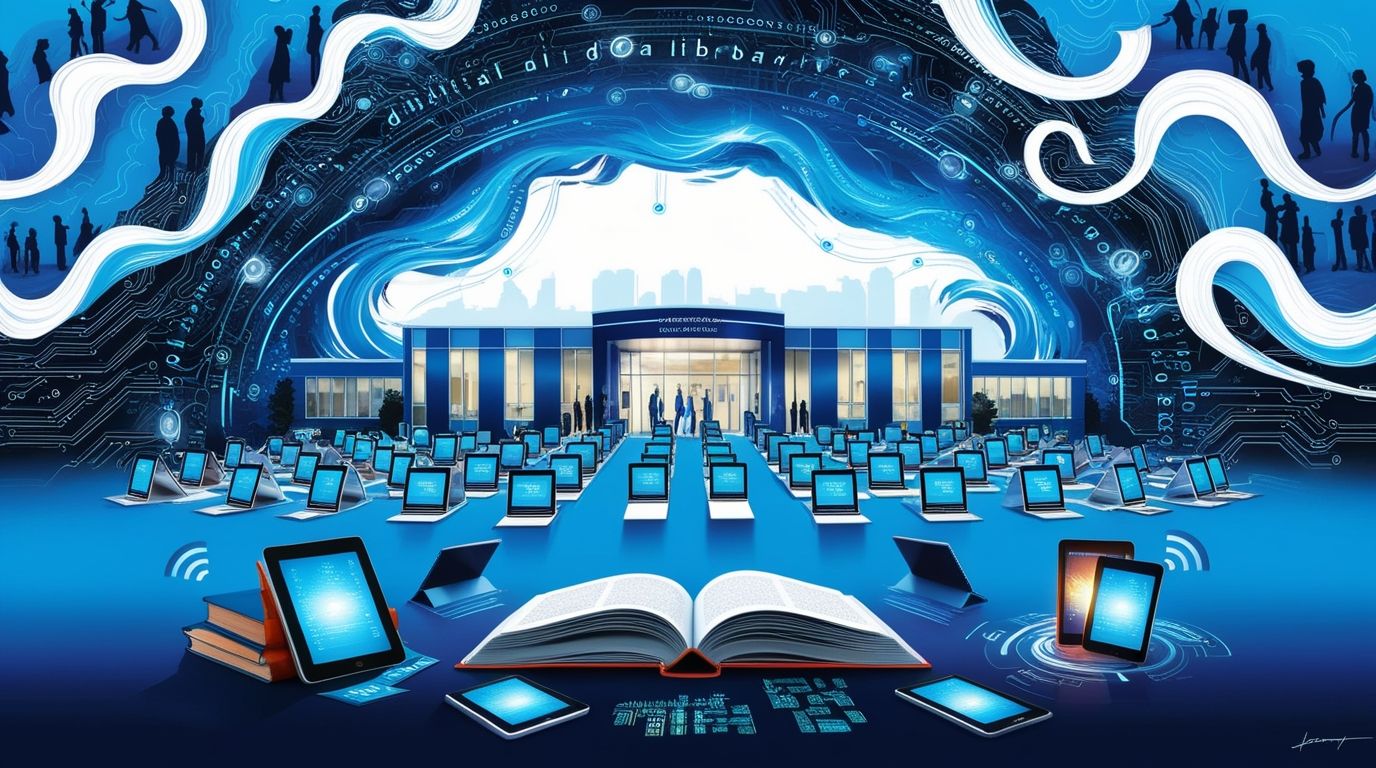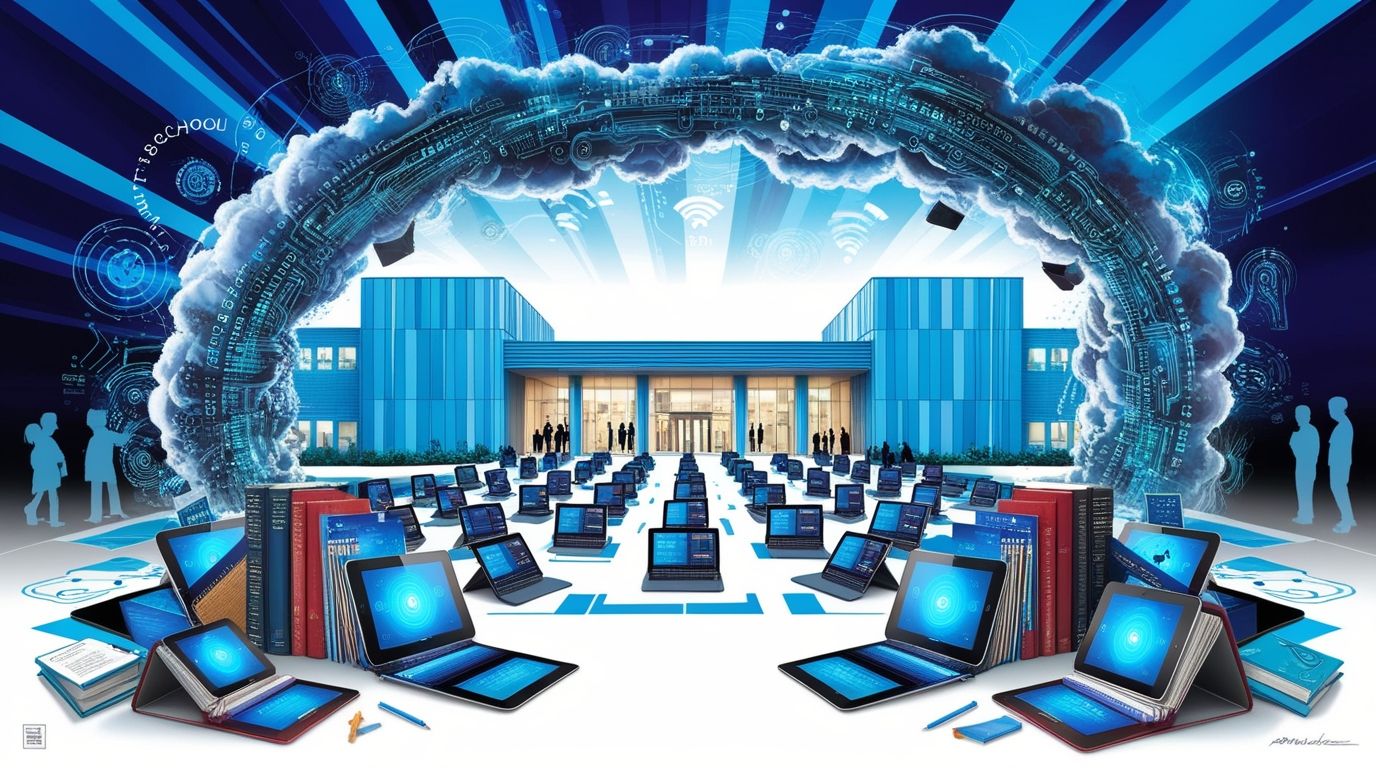Introduction
The Impact and Evolution of Digital Libraries in Schools Digital libraries have become integral to the modern educational landscape, revolutionizing how students and educators access and interact with information. These digital repositories offer a wealth of resources that are easily accessible, searchable, and often free, making them a vital tool for enhancing the educational experience. This article explores the significance, benefits, challenges, and future prospects of digital libraries in schools, aiming to provide a comprehensive understanding of their role in contemporary education.
The Significance of Digital Libraries
Digital libraries represent a significant shift from traditional libraries, which rely on physical books and resources. They offer a vast array of digital content, including e-books, academic journals, multimedia, and interactive learning materials. This transition is particularly important in the school environment, where access to up-to-date and diverse resources can greatly enhance the learning process.
Accessibility and Convenience
One of the primary advantages of digital libraries is their accessibility. Unlike physical libraries, which may have limited hours and resources, digital libraries are available 24/7 and can be accessed from anywhere with an internet connection. This is particularly beneficial for students who may not have the means to visit a physical library regularly or those who live in remote areas.
Moreover, digital libraries provide a convenient way for students to access the information they need. Advanced search functionalities enable users to quickly find specific materials, and digital formats allow for easy sharing and collaboration among students and educators.
Enhancing Learning and Teaching
Digital libraries support a more dynamic and interactive learning environment. They offer a variety of resources that cater to different learning styles and needs, from text-based materials to audio-visual content and interactive simulations. This diversity can help engage students more effectively and cater to individual learning preferences.
For educators, digital libraries provide a vast array of teaching materials and resources that can be integrated into lesson plans. They also offer professional development resources, helping teachers stay updated with the latest educational trends and research.
Promoting Digital Literacy
The Impact and Evolution of Digital Libraries in Schools In today’s digital age, it is crucial for students to develop digital literacy skills. Digital libraries play a vital role in this by providing a platform where students can practice and enhance these skills. Navigating digital libraries requires students to search for information effectively, evaluate the credibility of sources, and use digital tools to access and utilize information.
Challenges and Solutions
Despite their numerous benefits, digital libraries also face several challenges. One of the main issues is the digital divide – the gap between those who have access to modern information and communication technology and those who do not. This divide can hinder the effectiveness of digital libraries, particularly in under-resourced schools or communities.
To address this challenge, it is essential to ensure that all students have access to the necessary technology and internet connectivity. Schools can collaborate with government agencies, non-profit organizations, and private companies to provide the required infrastructure and devices. Additionally, digital literacy training for both students and teachers is crucial to maximize the benefits of digital libraries.
Another challenge is the need for effective management and organization of digital libraries. With vast amounts of information available, it is essential to have systems in place to curate, categorize, and update resources regularly. Schools can employ librarians or digital resource managers to oversee this process and ensure that the digital library remains a valuable educational tool.
Privacy and Security Concerns
The digital nature of these libraries also raises concerns about privacy and security. Schools must implement robust measures to protect the personal information of students and staff and ensure that the digital library’s content is secure from unauthorized access and cyber threats.

Case Studies: Successful Implementation of Digital Libraries
The Impact and Evolution of Digital Libraries in SchoolsSeveral schools around the world have successfully integrated digital libraries into their educational framework, providing valuable insights and best practices for others to follow.
Example 1: The School of the Future, Philadelphia
The School of the Future in Philadelphia has fully embraced digital libraries as a core component of its educational model. Students use laptops and tablets to access a wide range of digital resources, from textbooks to interactive learning modules. Additionally, The school’s digital library is integrated with its learning management system, allowing for seamless access to resources and assignment submissions.
Teachers at the School of the Future utilize digital libraries to create engaging and interactive lesson plans, incorporating multimedia and digital tools to enhance the learning experience. The school also offers professional development programs to help educators effectively use digital resources in their teaching.
Example 2: The Digital Library Project, India
In India, the Digital Library Project has transformed education in rural areas by providing digital resources to schools with limited access to traditional libraries. The project distributes tablets pre-loaded with educational content, including e-books, videos, and interactive lessons, to schools across the country.
The Digital Library Project also trains teachers and students in digital literacy skills, ensuring they can effectively use the provided resources. This initiative has significantly improved access to quality educational materials and enhanced the learning experience for students in under-resourced areas.
Future Prospects
The future of digital libraries in schools looks promising, with advancements in technology continually expanding their potential. Emerging technologies such as artificial intelligence (AI), virtual reality (VR), and augmented reality (AR) offer exciting possibilities for enhancing digital libraries.
AI can be used to personalize learning experiences, providing students with customized recommendations based on their interests and learning needs. VR and AR can create immersive learning environments, allowing students to explore historical events, scientific concepts, and other subjects in a more engaging and interactive way.
Furthermore, the integration of digital libraries with other educational technologies, such as learning management systems and educational apps, will continue to improve access to and the usability of digital resources.
Conclusion
The Impact and Evolution of Digital Libraries in Schools Digital libraries have the potential to significantly enhance the educational experience for students and teachers. They provide easy access to a vast array of resources, support diverse learning styles, promote digital literacy, and offer a convenient and flexible learning environment. However, it is essential to address the challenges of the digital divide, effective management, and privacy concerns to fully realize the benefits of digital libraries in schools.
As technology continues to evolve, digital libraries will undoubtedly play an increasingly important role in education, helping to create more dynamic, inclusive, and effective learning environments. Finally, by embracing these digital tools and addressing the associated challenges, schools can ensure that all students have access to the resources they need to succeed in the digital age.

Thank you for the auspicious writeup It in fact was a amusement account it Look advanced to far added agreeable from you However how can we communicate
Most of what you state is astonishingly accurate and that makes me ponder the reason why I had not looked at this with this light before. This particular piece really did turn the light on for me as far as this specific issue goes. However at this time there is actually just one point I am not really too cozy with so while I try to reconcile that with the actual central theme of the position, let me observe what the rest of your readers have to point out.Nicely done.
Platform Slot Gacor yang Membayar Besar dan Tepat Waktu, hanya di SIGMASLOT
o13iob
Wake up your way with this premium CD player alarm clock radio. Whether you prefer to rise with the AM/FM radio, your favorite CD, or a standard buzzer, this versatile alarm clock with CD player has you covered. Its intuitive design includes dual alarms, a large digital display, snooze/sleep timers, and USB charging for your phone. Enjoy high-quality stereo sound from a compact unit that fits easily on any bedside table or shelf. The best clock radios with CD player combine retro functionality with modern convenience—and this one leads the pack.
Rediscover your CD collection with this top-rated clock radio and CD player combo. Ideal for bedrooms, offices, or kitchens, it plays your favorite CDs while also offering a reliable alarm clock radio function. Dual alarms let you set separate wake-up times, and the clear digital display is easy to read day or night. With its stereo radio alarm clock capabilities and optional remote control, this CD alarm clock radio ensures comfort, convenience, and crisp audio in one stylish package. A top choice for those wanting the best CD alarm clock for sound and function.
That is really fascinating, You’re an excessively skilled blogger. I’ve joined your rss feed and look forward to in the hunt for more of your great post. Additionally, I’ve shared your site in my social networks!
you might have a great weblog right here! would you like to make some invite posts on my blog?
Some truly nice and useful info on this site, as well I think the layout holds superb features.
There are certainly numerous particulars like that to take into consideration. That may be a nice level to deliver up. I provide the thoughts above as general inspiration but clearly there are questions like the one you bring up where the most important thing will be working in sincere good faith. I don?t know if best practices have emerged round issues like that, however I am positive that your job is clearly recognized as a good game. Each boys and girls feel the impact of just a second’s pleasure, for the remainder of their lives.
F*ckin’ awesome things here. I am very happy to peer your article. Thank you a lot and i’m having a look forward to contact you. Will you please drop me a mail?
https://t.me/s/Official_1win_kanal/473
https://t.me/s/Webs_1WIN
Thank you for the auspicious writeup. It if truth be told was a enjoyment account it. Look complicated to more added agreeable from you! By the way, how could we keep up a correspondence?
I’d need to test with you here. Which is not one thing I often do! I get pleasure from studying a post that may make individuals think. Also, thanks for allowing me to comment!
Your style is so unique compared to many other people. Thank you for publishing when you have the opportunity,Guess I will just make this bookmarked.2
Thank you for the auspicious writeup. It in fact was a amusement account it. Look advanced to more added agreeable from you! By the way, how can we communicate?
he blog was how do i say it… relevant, finally something that helped me. Thanks
I appreciate, cause I found exactly what I was looking for. You have ended my 4 day long hunt! God Bless you man. Have a great day. Bye
After study a few of the blog posts on your website now, and I truly like your way of blogging. I bookmarked it to my bookmark website list and will be checking back soon. Pls check out my web site as well and let me know what you think.
Very well presented
Its good as your other articles : D, appreciate it for posting. “As experience widens, one begins to see how much upon a level all human things are.” by Joseph Farrell.